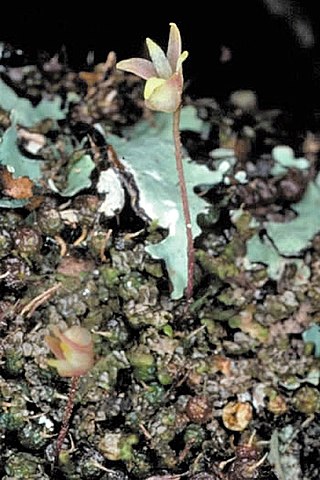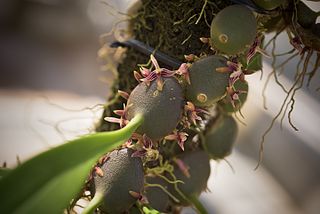
Bulbophyllum is a genus of mostly epiphytic and lithophytic orchids in the family Orchidaceae. It is the largest genus in the orchid family and one of the largest genera of flowering plants with more than 2,000 species, exceeded in number only by Astragalus. These orchids are found in diverse habitats throughout most of the warmer parts of the world including Africa, southern Asia, Latin America, the West Indies, and various islands in the Indian and Pacific Oceans. Orchids in this genus have thread-like or fibrous roots that creep over the surface of trees or rocks or hang from branches. The stem is divided into a rhizome and a pseudobulb, a feature that distinguished this genus from Dendrobium. There is usually only a single leaf at the top of the pseudobulb and from one to many flowers are arranged along an unbranched flowering stem that arises from the base of the pseudobulb. Several attempts have been made to separate Bulbophyllum into smaller genera, but most have not been accepted by the World Checklist of Selected Plant Families.

Bulbophyllum globuliforme, commonly known as the green bead orchid, miniature moss-orchid or hoop pine orchid, is a species of epiphytic orchid with tiny spherical pseudobulbs, scale-like leaves and small cream-coloured flowers with a yellow labellum. It grows on the scaly bark of hoop pine, mostly on the McPherson Range on the New South Wales/Queensland border in eastern Australia. Because of its small size it is often dismissed as moss.

Dinema is a genus of orchids. It is represented by a single currently accepted species, Dinema polybulbon, native to Mexico, Central America, and the Caribbean.

Cymbidium iridioides, commonly known as the Iris-Like Cymbidium is a species of boat orchid. It is a pseudobulbous epiphyte found from Himalaya to south-central China.

Bulbophyllum baileyi, commonly known as the fruit fly orchid, is a species of epiphytic or lithophytic orchid that is native to Queensland and New Guinea. It has coarse, creeping rhizomes, curved, yellowish pseudobulbs with a single thick, fleshy leaf, and a single cream-coloured flower with yellow, red or purple spots. It grows on trees and rocks in open forest, often in exposed places.
Bulbophyllum caldericola is a species of epiphytic or lithophytic orchid with inconspicuous, well-spaced pseudobulbs arranged along rhizomes which mostly hang from the surface on which they are growing. Each pseudobulb has a single, fleshy, channelled leaf and a single white flower with yellow tips. It grows on the trunks and larger branches of rainforest trees near the eastern border between New South Wales and Queensland.

Bulbophyllum cruciatum is a species of orchid in the genus Bulbophyllum found in Papua, Papua New Guinea, Seram Island, and Maluku Islands.

Bulbophyllum grandimesense, commonly known as the pale rope orchid, is a species of epiphytic orchid with well-spaced pseudobulbs and brown bracts arranged along the stems. Each pseudobulb has a single, fleshy, dark green leaf and usually only a single white flower with thread-like tips on the sepals. It grows on rainforest trees in a small area of tropical North Queensland.
Bulbophyllum lamingtonense, commonly known as the cream rope orchid, is a species of epiphytic or lithophytic orchid with well-spaced pseudobulbs and brown bracts arranged along the stems. Each pseudobulb has a single, fleshy, channelled leaf and a single cream-coloured or white flower with yellow tips. It grows on trees and rocks near cliffs and the edge of rainforest near the eastern border between New South Wales and Queensland.
Bulbophyllum lewisense, commonly known as the Mount Lewis rope orchid, is a species of epiphytic orchid with pseudobulbs and pale brown bracts arranged along the stems. Each pseudobulb has a single, dark green, channelled leaf and a single white flower with pointed tips on the sepals. It grows on the higher branches of rainforest trees, often where it is exposed to breezes on the higher tablelands of tropical North Queensland.

Bulbophyllum longiflorum, commonly known as the pale umbrella orchid, is a species of epiphytic or lithophytic orchid. It has a creeping rhizome, widely spaced, dark green pseudobulbs with a single large, fleshy leaf, and flowers spreading in a semicircular umbel, resembling one-half of an umbrella. The flowers are canoe-shaped, greenish cream-coloured to yellowish with purple dots. It has a wide distribution and is found in parts of Africa, on islands in the Indian and Pacific Oceans, Southeast Asia, New Guinea and northern Australia.
Bulbophyllum montense is a species of orchid in the genus Bulbophyllum found in Borneo.
Bulbophyllum radicans, commonly known as the striped pyjama orchid, is a species of epiphytic or lithophytic orchid with long, hanging stems with roots near the base and covered with brown, papery bracts which partially hide the pseudobulbs. Each pseudobulb has a single thin leaf. A single small pink, cream-coloured or yellow flower with red or purplish stripes is borne on a thin flowering stem that emerges from the base of the pseudobulb. This orchid grows on trees or rocks in or near rainforest in tropical North Queensland.

Bulbophyllum wadsworthii, commonly known as the yellow rope orchid, is a species of epiphytic or lithophytic orchid that forms clumps that hang off the surface on which the plant is growing. The pseudobulbs are small and partly hidden by brown, papery bracts. Each pseudobulb has a single fleshy, dark green leaf and a single star-shaped, cream-coloured or pale green flower with an orange labellum. It mainly grows on trees and rocks in rainforest and is endemic to Queensland.
Bulbophyllum windsorense, commonly known as the thread-tipped rope orchid, is a species of epiphytic orchid that has small pseudobulbs partly hidden by brown, papery bracts. Each pseudobulb has a single fleshy, dark green, grooved leaf and one or two cream-coloured or greenish flowers. It mainly grows near the breezy tops of trees, especially Callitris macleayana trees and is endemic to tropical North Queensland.
Bulbophyllum xanthornis is a species of orchid in the genus Bulbophyllum.

Prosthechea citrina, synonym Encyclia citrina, is a species of orchid native to southwest Mexico. It is known as tulip orchid and has a strong lemon fragrance. Its petals are golden yellow with varying degrees of white crenulations in the lip. The plant may be upright or pendant, but the flowers are always pendant. It is also known as the tulip orchid due to its flowers' rounded cup-like shape. It has been referred to for generations as costicoatzontecoxòchitl, meaning "flower in the form of yellow serpent head", by the Nahuas.

Bulbophyllum maxillare, commonly known as the red horntail orchid, is a species of epiphytic orchid with tapered grooved, dark green to yellowish pseudobulbs, each with a single large, thin leaf and a single reddish flower with yellow or white edges. The lateral sepals are much larger than the dorsal sepal which in turn is much larger than the petals. It grows on the lower branches of rainforest trees in India, New Guinea and tropical North Queensland.

Lepanthes kokonuko is a species of orchid from southern Colombia. L. kokonuko can be easily recognized by its caespitose medium-sized plants, elliptical coriaceous leaves, long loosely, flexuous and distichous inflorescences; strongly revolute lateral sepals, transversely bilobed petals with the upper lobe lanceolate (hornlike), and a bilaminate lip with the blades ovoid–lanceolate with a bipartite appendix.

Bulbophyllum sect. Ephippium is a section of the genus Bulbophyllum.












